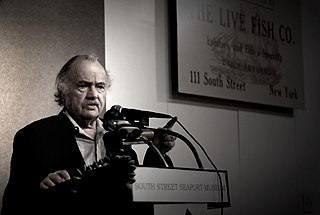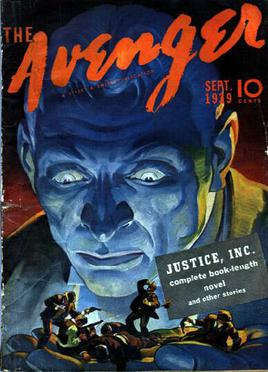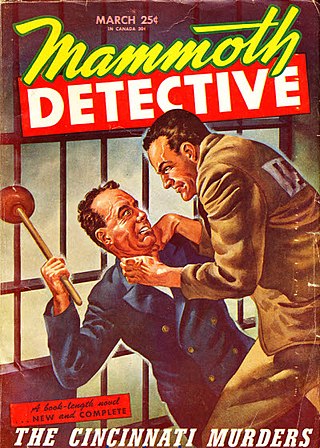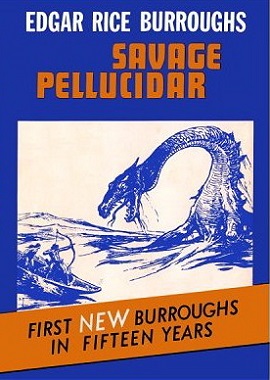Related Research Articles

Doc Savage is a fictional character of the competent man hero type, who first appeared in American pulp magazines during the 1930s and 1940s. Real name Clark Savage Jr., he is a doctor, scientist, adventurer, detective, and polymath who "rights wrongs and punishes evildoers." He was created by publisher Henry W. Ralston and editor John L. Nanovic at Street & Smith Publications, with additional material contributed by the series' main writer, Lester Dent. Doc Savage stories were published under the Kenneth Robeson name. The illustrations were by Walter Baumhofer, Paul Orban, Emery Clarke, Modest Stein, and Robert G. Harris.

The United States Copyright Office (USCO), a part of the Library of Congress, is a United States government body that maintains records of copyright registration, including a copyright catalog. It is used by copyright title searchers who are attempting to clear a chain of title for copyrighted works.

"In the Mood" is a popular big band-era jazz standard recorded by American bandleader Glenn Miller. "In the Mood" is based on the composition "Tar Paper Stomp" by Wingy Manone. The first recording under the name "In the Mood" was released by Edgar Hayes & His Orchestra in 1938.

Lester Dent was an American pulp-fiction writer, best known as the creator and main writer of the series of novels about the scientist and adventurer Doc Savage. The 159 Doc Savage novels that Dent wrote over 16 years were credited to the house name Kenneth Robeson.

Ronald Joseph Goulart was an American popular culture historian and mystery, fantasy, and science fiction author.

Kevin Plunder, also known as Ka-Zar, is a superhero appearing in American comic books published by Marvel Comics. Created by writer Stan Lee and artist Jack Kirby, the character first appeared in The X-Men #10. Kevin Plunder is the second character to use the codename Ka-Zar.

The Avenger is a fictional character whose original adventures appeared between September 1939 and September 1942 in the pulp magazine The Avenger, published by Street & Smith, which ran 24 issues. Five additional short stories were published in Clues Detective magazine (1942–1943), and a sixth novelette in The Shadow magazine in 1943. Decades later, newly written pastiches were commissioned and published by Warner Brothers' Paperback Library from 1973 to 1974.
"Ol' Man River" is a show tune from the 1927 musical Show Boat with music by Jerome Kern and lyrics by Oscar Hammerstein II. The song contrasts the struggles and hardships of African Americans with the endless, uncaring flow of the Mississippi River. It is sung from the point of view of a black stevedore on a showboat, and is the most famous song from the show. The song is meant to be performed in a slow tempo; it is sung complete once in the musical's lengthy first scene by the stevedore "Joe" who travels with the boat, and, in the stage version, is heard four more times in brief reprises. Joe serves as a sort of musical one-man Greek chorus, and the song, when reprised, comments on the action, as if saying, "This has happened, but the river keeps rolling on anyway."
Walter Ryerson Johnson was a 20th-century American pulp fiction writer and editor. He wrote in many genres, but is probably best known at having been one of the men who wrote Doc Savage novels, under the pseudonym Kenneth Robeson. He also published works under the names "Matthew Blood" and "Peter Field".
Lawrence Louis Donovan was an American pulp fiction writer who wrote nine Doc Savage novels under the pseudonym Kenneth Robeson, a pen name that was used by other writers of the same publishing house. However, there are nine Doc Savage novels duly credited to Donovan, published between November 1935 and July 1937.

William Gibson Bogart was an American pulp fiction writer. He is best known for writing several Doc Savage novels, under the pseudonym Kenneth Robeson.

Doc Savage: His Apocalyptic Life is a fictional biography by Philip José Farmer about pulp fiction hero Doc Savage.

William Murray is an American novelist, journalist, short story, and comic book writer. Much of his fiction has been published under pseudonyms. With artist Steve Ditko, he co-created the superhero Squirrel Girl.

Death in Silver is a Doc Savage pulp novel by Lester Dent writing under the house name Kenneth Robeson. It was published in October 1934.

Sanders of the River is a 1935 British film directed by the Hungarian-British director, Zoltán Korda, based on the stories of Edgar Wallace. It is set in Colonial Nigeria. The lead Nigerian characters were played by African Americans Paul Robeson and Nina Mae McKinney. The film proved a significant commercial and critical success, giving Korda the first of his four nominations for Best Film at the Venice Film Festival.

Savage Pellucidar is a 1963 fantasy story collection by American writer Edgar Rice Burroughs, the seventh and final book in his series about the fictional "hollow earth" land of Pellucidar. It was published twelve years after Burroughs's death.

Doc Savage was an American pulp magazine that was published from 1933 to 1949 by Street & Smith. It was launched as a follow-up to the success of The Shadow, a magazine Street & Smith had started in 1931, based around a single character. Doc Savage's lead character, Clark Savage, was a scientist and adventurer, rather than purely a detective. Lester Dent was hired to write the lead novels, almost all of which were published under the house name "Kenneth Robeson". A few dozen novels were ghost-written by other writers, hired either by Dent or by Street & Smith. The magazine was successful, but was shut down in 1949 as part of Street & Smith's decision to leave the pulp magazine field completely.

The Man of Bronze is a Doc Savage pulp novel by Lester Dent writing under the house name Kenneth Robeson. It was published in March 1933. It was the basis of the 1975 movie Doc Savage: The Man of Bronze starring Ron Ely.
The Avenger is the name of two old-time radio crime dramas in the United States. The first one was broadcast weekly on WHN in New York City, New York, July 18, 1941 – November 3, 1942. The second was syndicated nationally October 25, 1945 – April 18, 1946. It was the first program distributed by WHN Transcription Service, which previously had distributed only commercials.
References
- ↑ Office, Library of Congress Copyright (1976). Catalog of Copyright Entries. Third Series: 1974: July-December. Copyright Office, Library of Congress. p. 4361.